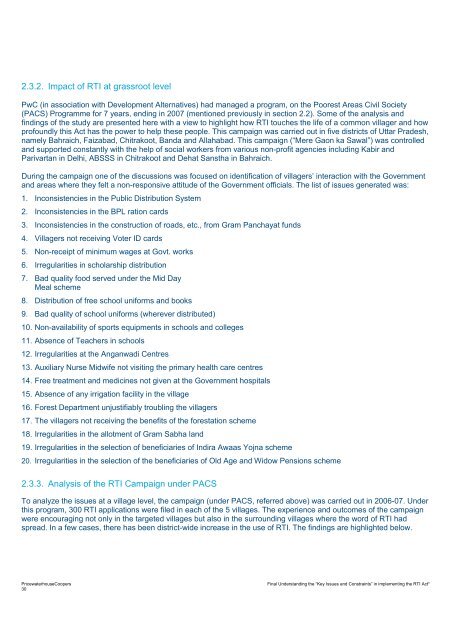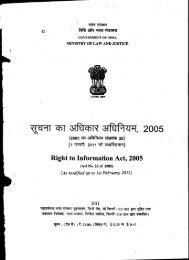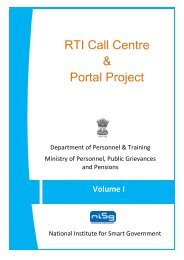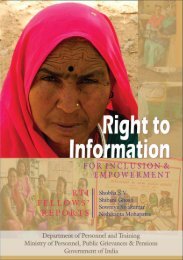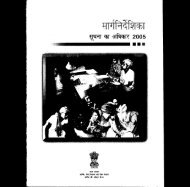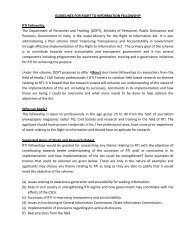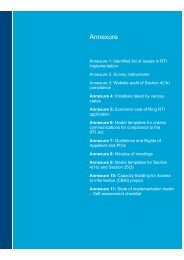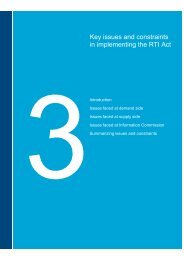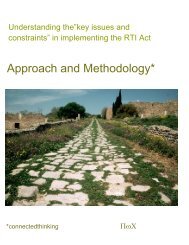Progress made so far - Right to Information Act
Progress made so far - Right to Information Act
Progress made so far - Right to Information Act
Create successful ePaper yourself
Turn your PDF publications into a flip-book with our unique Google optimized e-Paper software.
2.3.2. Impact of RTI at grassroot level<br />
PwC (in as<strong>so</strong>ciation with Development Alternatives) had managed a program, on the Poorest Areas Civil Society<br />
(PACS) Programme for 7 years, ending in 2007 (mentioned previously in section 2.2). Some of the analysis and<br />
findings of the study are presented here with a view <strong>to</strong> highlight how RTI <strong>to</strong>uches the life of a common villager and how<br />
profoundly this <strong>Act</strong> has the power <strong>to</strong> help these people. This campaign was carried out in five districts of Uttar Pradesh,<br />
namely Bahraich, Faizabad, Chitrakoot, Banda and Allahabad. This campaign (“Mere Gaon ka Sawal”) was controlled<br />
and supported constantly with the help of <strong>so</strong>cial workers from various non-profit agencies including Kabir and<br />
Parivartan in Delhi, ABSSS in Chitrakoot and Dehat Sanstha in Bahraich.<br />
During the campaign one of the discussions was focused on identification of villagers’ interaction with the Government<br />
and areas where they felt a non-responsive attitude of the Government officials. The list of issues generated was:<br />
1. Inconsistencies in the Public Distribution System<br />
2. Inconsistencies in the BPL ration cards<br />
3. Inconsistencies in the construction of roads, etc., from Gram Panchayat funds<br />
4. Villagers not receiving Voter ID cards<br />
5. Non-receipt of minimum wages at Govt. works<br />
6. Irregularities in scholarship distribution<br />
7. Bad quality food served under the Mid Day<br />
Meal scheme<br />
8. Distribution of free school uniforms and books<br />
9. Bad quality of school uniforms (wherever distributed)<br />
10. Non-availability of sports equipments in schools and colleges<br />
11. Absence of Teachers in schools<br />
12. Irregularities at the Anganwadi Centres<br />
13. Auxiliary Nurse Midwife not visiting the primary health care centres<br />
14. Free treatment and medicines not given at the Government hospitals<br />
15. Absence of any irrigation facility in the village<br />
16. Forest Department unjustifiably troubling the villagers<br />
17. The villagers not receiving the benefits of the forestation scheme<br />
18. Irregularities in the allotment of Gram Sabha land<br />
19. Irregularities in the selection of beneficiaries of Indira Awaas Yojna scheme<br />
20. Irregularities in the selection of the beneficiaries of Old Age and Widow Pensions scheme<br />
2.3.3. Analysis of the RTI Campaign under PACS<br />
To analyze the issues at a village level, the campaign (under PACS, referred above) was carried out in 2006-07. Under<br />
this program, 300 RTI applications were filed in each of the 5 villages. The experience and outcomes of the campaign<br />
were encouraging not only in the targeted villages but al<strong>so</strong> in the surrounding villages where the word of RTI had<br />
spread. In a few cases, there has been district-wide increase in the use of RTI. The findings are highlighted below.<br />
PricewaterhouseCoopers Final Understanding the “Key Issues and Constraints” in implementing the RTI <strong>Act</strong>*<br />
30


